The use of walnut leaf biomass as a natural mulch and an eco-friendly practice can help prevent weed seed germination by excluding light and/or acting as a physical barrier that prevents weed emergence. Beyond that, several studies have shown potential allelopathic effects of juglone and leaf extracts of walnut on seed germination and seedling root and shoot growth (Kocacë and Terzi, 2001; Zhang et al., 2008; Chauhan et al., 2022; Đorđević et al., 2022).
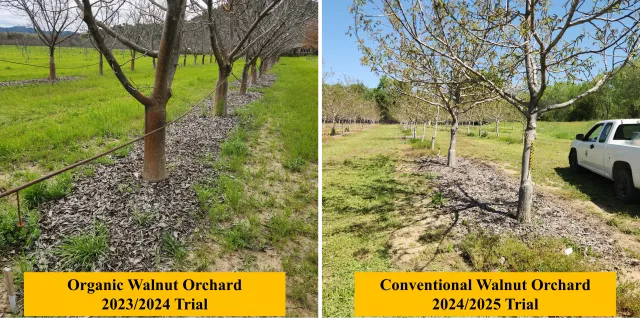
Despite the multiple benefits of walnut leaf mulch for weed control, this strategy has been little adopted by growers or recommended by managers and Pest Control Advisors (PCAs) in California. Walnut leaf mulch is particularly challenging because of the lack of field research available in the literature regarding weed control effectiveness, the impact of this strategy on soil organic matter accumulation, soil moisture, soil temperature, root diseases, vertebrate and invertebrate pest populations, and the concern that the presence of the mulch would interfere with winter sanitation.
Given the importance of finding an integrated and low-input strategy for weed management, field research trials were conducted in the 2024/2025 growing season in one organic and one conventional walnut orchard with an existing stand of mixed grass and broadleaf weeds to assess the walnut leaf biomass mulch thickness required for adequate weed suppression (Fig. 1).
One of the benefits of using walnut leaf as mulch is that growers will not have additional costs associated with the transportation or purchase of other mulch sources. An established walnut orchard may produce enough biomass to cover the tree rows.
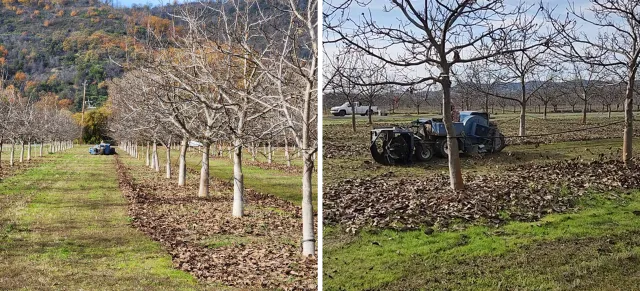
The only requirement and added cost to this management strategy is to sweep the leaves into the tree rows after harvest in late fall or early winter (Fig. 2).
Our results have demonstrated that walnut leaf mulch effectively suppresses the weed community in the tree rows (Fig. 3). Both four and eight-inch-thick mulch were enough for effective control of annual winter and summer weeds throughout the growing season. The results showed that even in the late summer, control was still greater than 60% even with four-inch-thick mulch (Fig. 3).
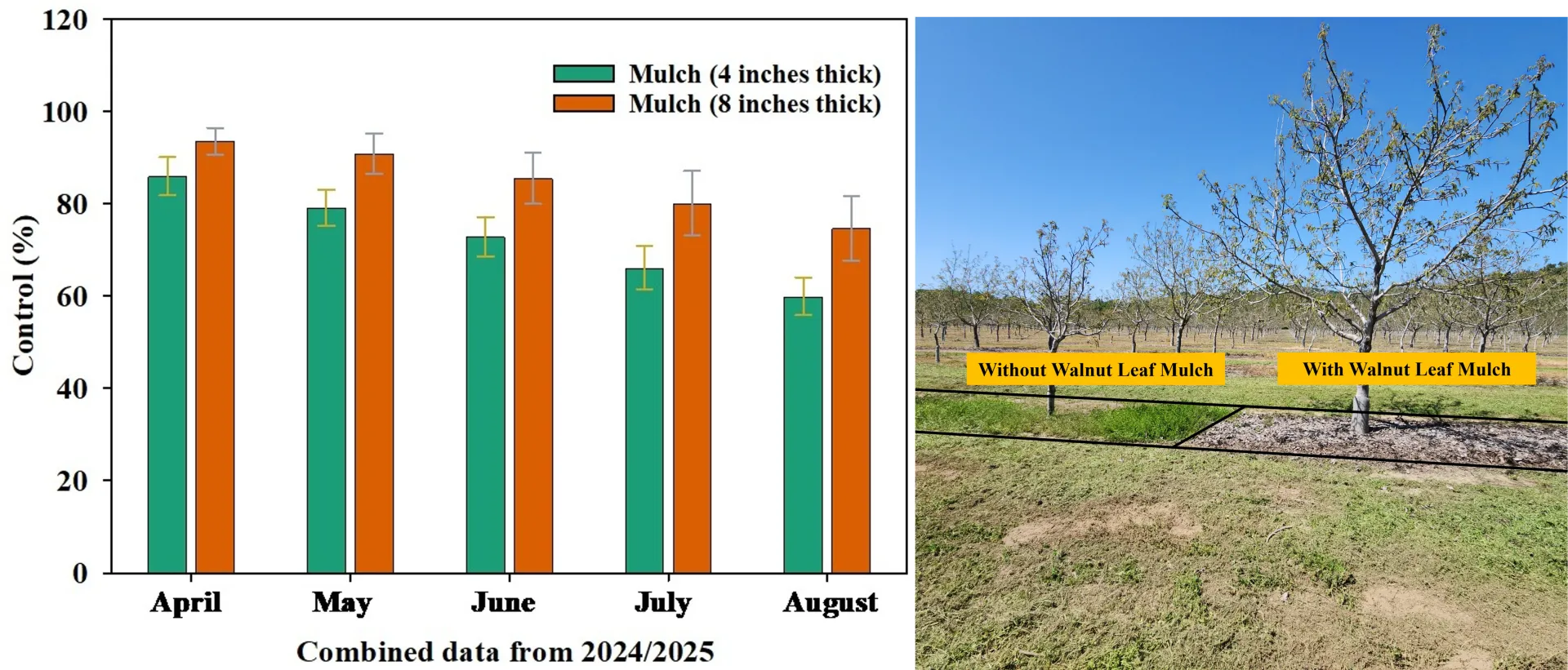
Perennial weeds such as field bindweed (Convolvulus arvensis) and blackberry (Rubus spp.) proved more challenging to control (Fig. 4), and over time, emerged through the four-inch-thick mulch more frequently compared to the eight-inch-thick mulch.

In addition, we also observe a reduction in soil temperature in the plots using the walnut leaf mulch of greater than 5 °F. The reduction in temperature may contribute to holding the soil moisture for an extended period of time in the tree rows by preventing evaporation from occurring at the soil surface when compared to bare soil control plots (data not collected).
It is expected that walnut leaf mulch will degrade relatively quickly, avoiding biomass accumulation on the soil surface by the harvest time. However, growers should be aware that too thick mulch may lead to a high accumulation of biomass in the tree row. Mulch that is greater than 10 inches in thickness can make mowing difficult in the tree rows before harvest and may affect the harvesting process by affecting the sweep of the nuts.
Soil disturbance by wild pigs was observed in both orchard sites where the leaf mulch weed management strategy was implemented. The accumulation of biomass in the tree rows associated with soil humidity and temperature may attract wild pigs to dig the tree rows' soil profile, looking for earthworms or other food sources (Fig. 5). This may be a drawback associated with this type of weed management strategy in sites with wild pig infestations.
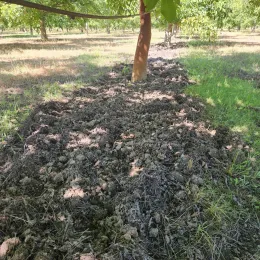
Organic and Conventional walnut growers in Lake County, CA, have implemented walnut leaf mulch for weed management successfully, as shown in the following examples. In organic farming systems, growers have reported a reduction in the number of mowings in the tree rows. Growers have also reported the benefits of this integrated weed management practice in conventional farming systems. As a result, conventional growers were able to reduce the volume of herbicide applications by adopting spot applications (Fig. 6A) or by projecting the herbicide spray line outside the mulch line/tree rows (Fig. 6B). In particular, the strategy of projecting the herbicide spray line away from the tree rows may bring several benefits, such as reducing the number of mowings in the middle, mitigating the risks of herbicide uptake by the trees, and reducing the potential risks of tree trunk damage due to overreliance on a number of herbicide sprays over time.
As a low-input strategy, the results of those studies suggest that walnut leaf mulch may be implemented as a sound integrated weed management practice. This research establishes successful documented cases of using walnut leaf biomass mulch to provide integrated weed management in organic and conventional walnut farming systems. Several benefits can be expected when adopting this management strategy, including improved economic profitability, environmental sustainability, and resilience of walnut orchards.
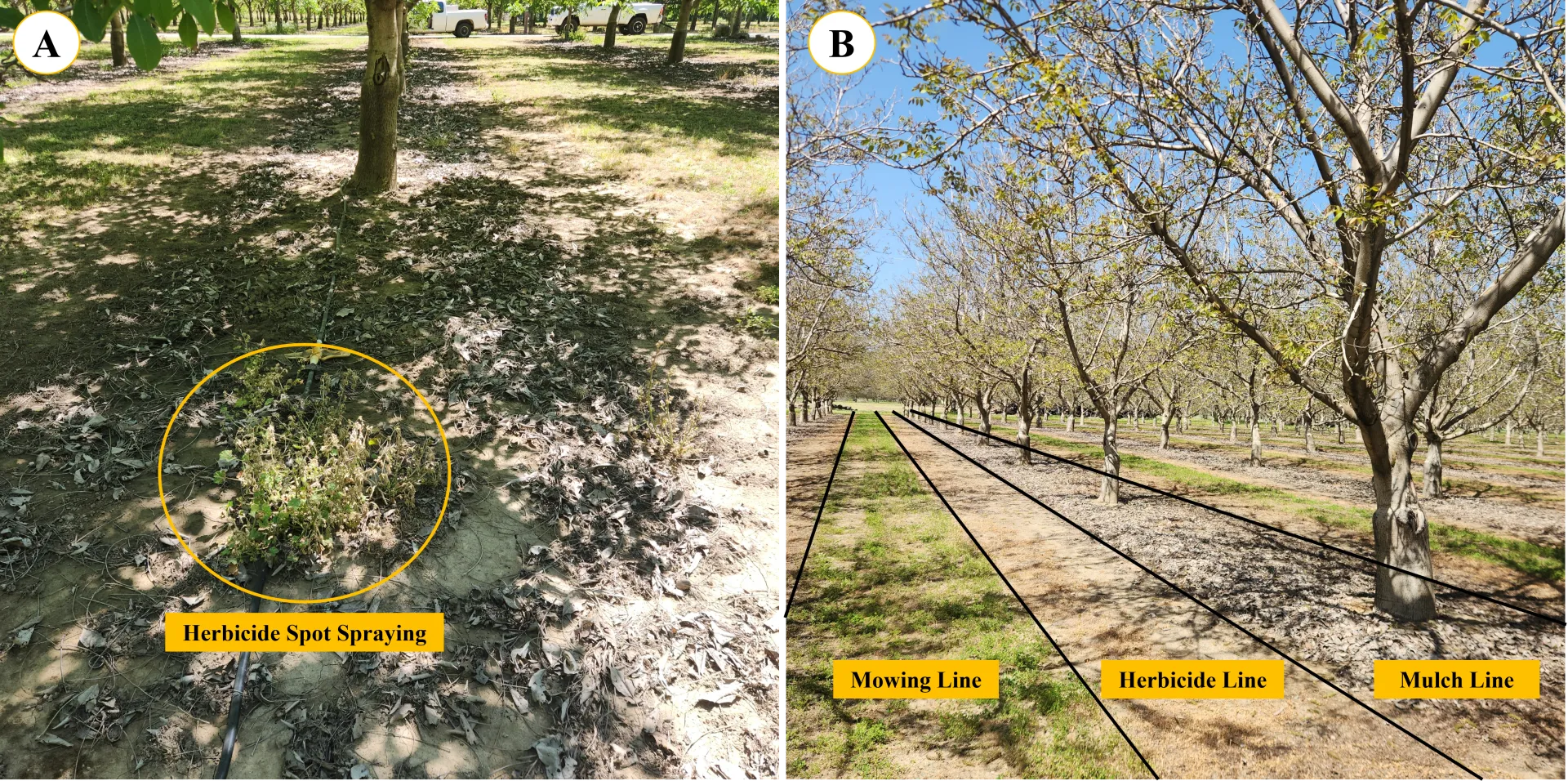
However, there are still several knowledge gaps that require further study, including the impact of this strategy on soil organic matter, soil quality, tie-up of soil nitrogen, soil moisture, diseases (root or crown rot or canker disease caused by soil moisture), vertebrate and invertebrate pest populations, and the selection of new weed community species more adapted to this type of weed management (perennial weeds establishing and spreading from rhizomes or stolons). For all these reasons, it is difficult to determine when and how walnut leaf mulch should be used. This lack of information warrants additional research regarding the effectiveness of walnut leaf mulch practices in short and long-term perspectives.
ACKNOWLEDGMENT
We thank the grower cooperators for allowing these trials to be conducted at the Walnut Orchards. We thank the UCCE agricultural technicians for field support.
REFERENCES
Kocacë Aliskan, I., & Terzi, I. (2001). Allelopathic effects of walnut leaf extracts and juglone on seed germination and seedling growth. The Journal of Horticultural Science and Biotechnology, 76(4), 436-440.
Zhang Hai, Z. H., Gao JinMing, G. J., Liu WeiTao, L. W., Tang JingCheng, T. J., Zhang XingChang, Z. X., Jin ZhenGuo, J. Z., ... & Shao MingAn, S. M. (2008). Allelopathic substances from walnut (Juglans regia L.) leaves.
Chauhan, P. S., Dhingra, G. K., & Kousar, S. (2022). Allelopathic effects of Juglans regia leaf extract on seed germination and seedling growth of wheat (Triticum aestivum) and rye (Secale cereale). Archives of Agriculture and Environmental Science, 7(1), 8-11.
Đorđević, T., Đurović-Pejčev, R., Stevanović, M., Sarić-Krsmanović, M., Radivojević, L., Šantrić, L., & Gajić-Umiljendić, J. (2022). Phytotoxicity and allelopathic potential of Juglans regia L. leaf extract. Frontiers in Plant Science, 13, 986740.
